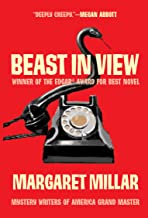Beast in View by Margaret Millar
Tags: crime-fiction,
Margaret Millar’s Beast in View opens with thirty-year-old Helen Clarvoe receving an unnerving, vaguely threatening phone call from a woman who claims to have once been her friend. Clarvoe is the sole daughter of a wealthy Southern California family whose dysfunction will be familiar to readers of the Lew Archer mysteries written by Millar’s husband, Ross Macdonald.

The time is 1955, the place, Los Angeles. Miss Clarvoe, estranged from her mother and brother, spends most of her days alone in her room in the Monica Hotel, her door “locked against the ugliness of the world.” The caller, Miss Evelyn Merrick, tells Helen she has foreseen in her crystal ball an accident that will befall her, and goes on to describe the wounds. After Helen Clarvoe suffers an accident close enough to the one described, she calls the only man she knows and asks for help.
Paul Blackshear, the fifty-year-old investment adviser to Helen’s late father, is bored with life and looking for an adventure. He decides to track down the caller, whom he suspects to be vindictive and somewhat unhinged. He’ll find out why she’s been harrassing Helen Clarvoe, and then report back.
So begins a detective tale in the mold of Raymond Chandler or Ross Macdonald. But the richness of Millar’s stories lies not only in the slow unfolding and unexpected twists of the mystery, but in the richness of her characterization and the extraordinary grace and wit of her prose.
Millar tells the story in third person, with alternating chapters taking the perspective of different characters. She gets inside their heads to provide a rich and detailed portrait, particularly of Helen Clarvoe, her mother Verna, and the vividly unhinged stalker, Evelyn Merrick.
Evelyn practices an especially sinister brand of evil. She stokes the secret fears of her targets, turning against those closest to them, so they can destroy each other.
The style and tone of Millar’s prose changes to suit the characters. The writing in the opening chapter, in which Miss Clarvoe is alone in her room, feels overly formal and dated. It is, as the narrator describes Helen Clarvoe herself, “constrained.” That changes in later chapters, to suit the subject, the scene, and the cast of mind of the character with whom the reader’s perspective is most closely aligned.
Millar has a gift for bringing characters to life through both description and dialog. A number of the minor players that Blackshear encounters in his investigation would have been flat and one-dimensional in the hands of other authors, mere messengers of information to guide the detective toward his goal.
Millar’s throwaway characters–the charm school matron, the doting mother, the solicitous, self-pitying madam of the skid-row brothel–are fully drawn, providing not only vivid portaits of individual psychologies, but of individuals inhabiting (or trapped in) specific roles within a stratified society. As in Ross Macdonald’s Black Money, Beast in View brings the reader into contact with every element level of Southern California society, from the madame, Miss Bella at the bottom, to the Clarvoe family at the top.
I won’t give away the plot, because it’s a good one. Even if it weren’t, the exceptional quality of Millar’s prose would make the book worth reading simply on its literary merits.
It’s a shame Millar’s work isn’t more well-known. In her day, she was popular with readers and deeply respected among authors, and she should be still. Penguin / Random House has reissued a number of her works, and Syndicate Books has published the full collection in seven volumes.
Unlike other popular mystery authors, who wrote series featuring a single detective, Millar experimented with a number of one-off works, starting fresh each time and having to build her world anew. That may account for her diminished popularity, as she left no signature detective for readers to latch onto. But the path she chose allowed her to develop a breadth and depth that other popular authors, constrained to a single main character, couldn’t match. She really is a master, and this is one of her best works. Read it if you can find a copy.